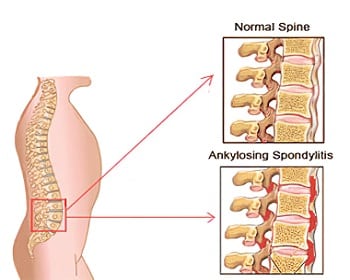
What is Spondylitis?
Spondylitis is one of more than 100 types of arthritis. Meaning “inflammation of the vertebrae,” “spondylitis” (more specifically, ankylosing spondylitis ) is a term for an autoimmune disease that is characterized by inflammation that attacks the sacroiliac (SI) joints, which connect the pelvis and sacrum. From here, inflammation and stiffness typically spreads upward, affecting the vertebrae and facet joints of the lumbar (lower back), thoracic (mid-back) and cervical (neck) regions of the spine. Long-term, or chronic, inflammation can erode the concave vertebral endplates between which intervertebral discs are sandwiched, which eventually flattens and squares off the end of individual vertebrae.
The discs, tendons and ligaments along the way can also be affected by inflammation and eventually ossify, a process in which soft tissue progressively turns to bone. As a result, the ossified spinal components can lead to complete spinal fusion and a number of spinal deformities. The condition can cause varying degrees of localized joint and disc pain, stiffness, and tenderness. Although neuropathic symptoms are not a primary result of ankylosing spondylitis, shooting pain, numbness, tingling, and weakness can arise if spinal cord and nerve root compression occur.
Types of Spondylitis
Spondylitis is an umbrella term that is often used by physicians to refer to a group of chronic conditions that involve inflammation of the spinal vertebrae or facet joints. This group of micro-conditions includes ankylosing spondylitis, psoriatic arthritis, undifferentiated spondyloarthropathy, juvenile spondyloarthropathy, reactive arthritis and enteropathic arthritis. The most common of these is ankylosing spondylitis, which is a spine condition that describes the stiffness and pain in the spine caused by arthritis in the joints and vertebrae. When left untreated, ankylosing spondylitis can cause limited mobility and debilitating pain, especially if the inflamed joints compress a local nerve root.
Causes of Spondylitis
Spondylitis is a complex spine condition. The exact cause is unknown, but research strongly suggests that genetics play a main role in the development of the disease. This is evidenced by the fact that the majority of people with spondylitis carry a gene called HLA-B27. This gene is found in more than 95 percent of Caucasian people with ankylosing spondylitis, although in other ethnic groups, the association between the presence of HLA-B27 and the development of ankylosing spondylitis varies. In addition, the majority of people with HLA-B27 never develop ankylosing spondylitis, so it’s clear that something else is involved in starting the disease. Some additional risk factors of developing spondylitis include:
- Bacterial infections – Bacterial infections, particularly those in the gastrointestinal tract, appear to trigger ankylosing spondylitis in people who have the genetic makeup for the disease.
- Having family members with ankylosing spondylitis – People with the HLA-B27 gene who have relatives with ankylosing spondylitis are more likely to develop it themselves.
- The presence of other genetic markers – Other genes, including IL23R and ARTS1, appear to be linked to the development of ankylosing spondylitis.
Treatment options for spondylitis
Your doctor will likely begin your treatment with conservative pain relief options, such as physical therapy, hot/cold compresses, stretches and pain medication. Many conservative treatment options are available to you, so you and your doctor can work together to find the combination of therapies that best relieves your pain. If you do not respond to conservative treatment, you may need to consider a surgical option
Suffering from Spondylitis?
Call us at anytime at 1-888-409-8006 and ask us about the Possible Treatments & Procedures for Ankylosing Spondylitis .
